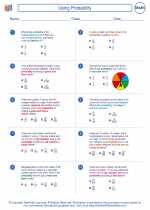Solution in Mathematics
A solution in mathematics refers to the value or values that make an equation or inequality true. When you solve an equation or inequality, you are finding the solution or solutions that satisfy the given mathematical statement.
Types of Solutions
There are different types of solutions based on the type of equation or inequality being solved:
- One Solution: An equation or inequality has exactly one value that satisfies it. This is also known as a unique solution.
- No Solution: An equation or inequality has no value that satisfies it. This means that there is no solution that makes the statement true.
- Infinitely Many Solutions: An equation or inequality has an infinite number of values that satisfy it. This typically occurs in equations involving variables that can be eliminated, resulting in a true statement.
Finding Solutions
There are various methods to find solutions to equations and inequalities, including:
- Substitution: Substitute a value into the equation or inequality to check if it satisfies the statement.
- Algebraic Manipulation: Use algebraic techniques such as factoring, combining like terms, or isolating variables to solve for the unknown value.
- Graphing: Graph the equation or inequality on a coordinate plane to visually identify the points of intersection or solutions.
- System of Equations: Solve a system of equations to find the common solution(s) that satisfy all equations in the system.
Study Guide
To understand and master the concept of solutions in mathematics, consider the following study guide:
- Review the basic principles of solving one-step and two-step equations.
- Practice solving inequalities and understanding the concept of solution sets.
- Explore real-world problems and scenarios that can be represented by equations or inequalities, and find their solutions.
- Work on challenging problems that involve systems of equations, where multiple equations need to be solved simultaneously to find the common solution.
- Utilize online resources, textbooks, and practice problems to reinforce your understanding of finding solutions in various mathematical contexts.
By mastering the concept of solutions in mathematics, you'll be better equipped to solve a wide range of mathematical problems and understand the significance of finding values that satisfy equations and inequalities.
[Solution] Related Worksheets and Study Guides:
.◂Math Worksheets and Study Guides Seventh Grade. Using Probability
Study Guide Using Probability
Using Probability  Worksheet/Answer key
Worksheet/Answer key Using Probability
Using Probability  Worksheet/Answer key
Worksheet/Answer key Using Probability
Using Probability  Worksheet/Answer key
Worksheet/Answer key Using Probability
Using Probability 

 Worksheet/Answer key
Worksheet/Answer key
 Worksheet/Answer key
Worksheet/Answer key
 Worksheet/Answer key
Worksheet/Answer key

The resources above cover the following skills:
Data Analysis and Probability (NCTM)
Understand and apply basic concepts of probability
Compute probabilities for simple compound events, using such methods as organized lists, tree diagrams, and area models.